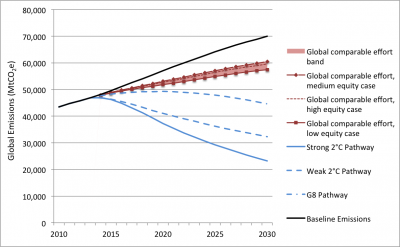Comparable Effort Worksheet
With the question of ambition and comparability of efforts looming large in the upcoming period of countries putting their cards (aka “Intended Nationally Determined Contributions”, or INDCs) on the table with regards to their envisioned climate pledges for the December 2015 Paris Climate Summit, I have been working on a tool to answer the question “If a country A suggests a certain level of effort for itself, what would be the equivalent effort of country B?” (I will call country A the Reference Country and its pledge shall henceforth be known as the Reference INDC).
The purpose of this exercise is to make pledges comparable across countries to be able to identify leaders and laggards/freeriders. In my particular tool, I am using the conceptual framework of the Climate Equity Reference Project, which allows me to think about the Reference INDC as a fraction of what would be the Reference Country’s fair share contribution to the global effort to stem the climate crisis. An comparable effort, or equivalent effort, of country B would then be an INDC that represents the same fraction of country B’s fair share contribution.
Since in the current world, an assessment of INDCs unfortunately is always an assessment of the collective inadequacy of the global response to the climate crisis, the tool starts out with an assessment of the question “how would we do, globally and in comparison to the emissions trajectories that we ought to be on, if every country would make an effort comparable/equivalent to the Reference INDC”. Here is a screenshot of that assessment from the tool using the EU’s INDC as Reference and the help text that the tool provides for interpreting the chart:
Prior to assessing comparable efforts based on the Reference INDC, it is prudent to assess the global ambition gap associated with the Reference INDC. For most, if not all, INDCs it is expected that there will be a substantial shortfall in ambition compared to the global mitigation trajectory required Therefore, any comparable effort analysis, as that presented in section 4 below, will virtually always be an analysis of comparable inadequacy of INDCs.
Consider the case of the Reference INDC of EU 28 here. As calculated in the table (in section 2) above, this INDC is expected to lead to mitigation of 2,006 Mt below BAU in 2030. Given that the total fair share obligation of EU 28 is between 7,528 Mt and 9,894 Mt, according to the scenarios considered here, the Reference INDC is equivalent with proposing to meet only between 20.3% and 26.6% of this total fair share obligation.
If every country in the world would likewise put forward INDCs that are equivalent to between 20.3% and 26.6% of their own total fair share obligation, the resulting overall global ambition (or “Global comparable effort”) would be as indicated in the chart below. For example, in 2030, the resulting range of global comparable mitigation effort would be 9,477 Mt to 12,455 Mt, compared to the overall mitigation need of 46,737 Mt for the Strong 2°C Pathway. Clearly, it can be seen that the overall global mitigation achieved in this scenario would still leave a large shortfall, even if one takes the lower edge of the global comparable effort band. (The 2,006 Mt mitigation implied by the INDC of EU 28 is only 4.3% of the 46,737 Mt of mitigation required to reach the Strong 2°C Pathway.)
(For more information on assessing the global mitigation implications of individual INDCs and for interpreting the shortfall, see the note “Comparable Efforts in a Low Ambition World”, http://climateequitereference.org/2015/03/13/comparable-effort-in-a-low-ambition-world)
The tool is implemented in Excel (but don’t let that discourage you from trying it; I really tried to make it really user friendly and there is plenty of documentation and instruction in the file and really only a tiny bit of user input required: essentially just 3 bits of information about the Reference INDC). There are also a number of pre-populated versions of the tool available for your most convenient start with using it. Those are hosted over on the Climate Equity Reference Project website.
Let me know what you think: cholz@climate.works
